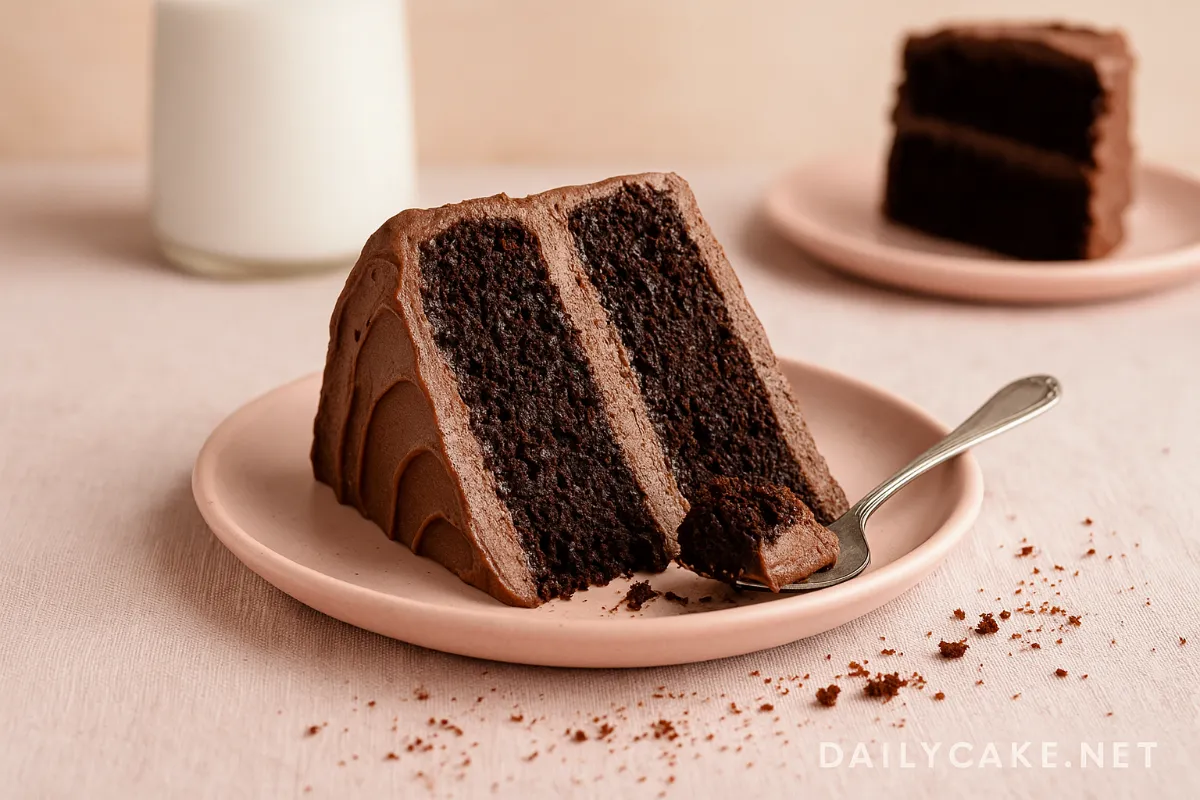Gluten-free vegan chocolate cake sounds like something trying too hard—but this one gets it right. If you’ve ever ended up with a dry, crumbly, or strangely textured cake while trying to bake without gluten, dairy, or eggs, I feel your pain. This recipe is my go-to for rich, moist, chocolatey cake that just happens to be friendly to nearly every dietary need. If you’re looking for variety, here’s another trusted vegan chocolate cake recipe that’s worth checking out. In this article, I’ll walk you through how I created this cake, the key ingredients, what substitutions really work, and how to make it turn out perfectly every time. Let’s bake something that actually tastes like cake.
Table of Contents
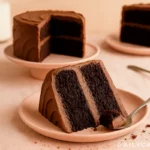
Gluten-Free Vegan Chocolate Cake
- Total Time: 50 minutes
- Yield: 10 servings 1x
Description
A rich, moist, and allergy-friendly gluten-free vegan chocolate cake that’s easy to make and perfect for any occasion.
Ingredients
1 ½ cups gluten-free all-purpose flour
½ cup unsweetened cocoa powder
1 cup cane sugar
1 tsp baking soda
½ tsp salt
2 tbsp ground flaxseed + 5 tbsp water
1 cup non-dairy milk
⅓ cup unsweetened applesauce
⅓ cup neutral oil (avocado or sunflower)
1 tsp vanilla extract
1 tbsp apple cider vinegar
¼ cup melted vegan dark chocolate (optional)
Instructions
1. Preheat oven to 350°F (175°C). Grease and line your cake pans.
2. Make flax eggs by mixing flaxseed and water. Let sit 10 minutes.
3. Mix dry ingredients in a large bowl.
4. Whisk wet ingredients together in a separate bowl.
5. Combine wet and dry mixtures, then stir in flax eggs.
6. Fold in melted chocolate if using.
7. Pour into pans and smooth the tops.
8. Bake for 30–35 minutes until a toothpick comes out with a few moist crumbs.
9. Cool in pans 10 minutes, then transfer to a rack.
10. Frost when completely cooled.
Notes
You can make this cake a day ahead and frost later.
Stores well in fridge up to 5 days or freeze unfrosted layers for 1–2 months.
- Prep Time: 15 minutes
- Cook Time: 35 minutes
- Category: Dessert
- Method: Baking
- Cuisine: American
Nutrition
- Serving Size: 1 slice
- Calories: 320
- Sugar: 24g
- Sodium: 180mg
- Fat: 14g
- Saturated Fat: 5g
- Unsaturated Fat: 8g
- Trans Fat: 0g
- Carbohydrates: 45g
- Fiber: 4g
- Protein: 3g
- Cholesterol: 0mg
Keywords: gluten-free vegan chocolate cake, vegan dessert, allergy-friendly cake
The Story Behind This Gluten-Free Vegan Chocolate Cake
Why I Needed a Great Gluten-Free Vegan Chocolate Cake
A few years ago, I got a text from a friend asking if I could bring dessert to a birthday dinner. No problem. Then came the follow-up: “Oh, by the way, it needs to be vegan and gluten-free.” I’d never made a gluten-free vegan chocolate cake before, and I wasn’t sure where to begin.
My first attempt was far from perfect. It was dense in the middle, crumbled on the edges, and tasted more like cocoa-flavored cornbread than anything I’d want to serve at a celebration. But I wasn’t about to give up. I started testing again. And again. And again.
I learned that it’s not about simply swapping out regular ingredients. It’s about finding combinations that replace what gluten and eggs normally do—provide structure, moisture, and lift. I started getting more curious about how ingredients interact. I took notes, adjusted ratios, and paid close attention to texture and rise.
Finally, one rainy Tuesday afternoon, I nailed it. The cake came out rich and soft, with deep chocolate flavor and just enough structure to slice cleanly. I covered it with a glossy vegan ganache and brought it to the party. No one asked if it was vegan. No one guessed it was gluten-free. Everyone just asked for seconds.
That moment made me realize how powerful a good dessert can be—not just for satisfying a craving but for bringing people together around the same table, regardless of food restrictions.
This recipe has become a staple in my kitchen ever since. It’s the kind of cake that doesn’t taste like it’s missing anything. And it’s a reminder that delicious food doesn’t need to be complicated—or exclusive.
What Makes This Cake Work—And Taste So Good
Here’s the thing: when you’re baking a gluten-free vegan chocolate cake, you’re replacing some of the key ingredients that usually give cake its magic—flour, eggs, and dairy. But you don’t need fancy tools or rare ingredients. You just need to understand how to rebuild the foundation.
To replace gluten, I use a reliable gluten-free all-purpose flour blend. One with rice flour, potato starch, and xanthan gum works best. The gum helps mimic the elasticity gluten usually provides, which keeps the cake from falling apart.
Eggs are often used to bind and lift. I swap them with flax eggs—just ground flaxseed mixed with water. They gel up nicely and hold the batter together, all while adding a hint of nuttiness that deepens the overall flavor.
For moisture, I rely on unsweetened applesauce and non-dairy milk like almond or soy—each offering a unique texture, as explored in this guide to the best plant-based milks for baking cakes. This combo keeps the cake soft and balanced—never oily or dry. It also allows the cocoa and melted chocolate to shine.
Speaking of chocolate, I double up. I use both unsweetened cocoa powder and melted vegan dark chocolate. This gives the cake a deep, rich flavor that satisfies every chocolate lover.
Lastly, to make it rise without eggs, I combine baking soda and vinegar. This mix bubbles up when it hits the wet ingredients, creating a light and fluffy texture. Interestingly, this technique dates back to the Great Depression, when people baked without eggs or milk due to rationing. That’s why this style of cake is often called a depression cake—and it just so happens to fit perfectly with modern vegan and gluten-free needs.
The end result? A tender, chocolatey cake with the kind of crumb that makes you close your eyes when you take a bite. You don’t have to settle for “good for gluten-free.” This cake is just plain good. If you’re curious about other chocolate cake alternatives, even those that aren’t vegan or gluten-free, try this chocolate cake with cottage cheese—surprisingly moist and protein-packed.
Summary Table: Core Substitutions That Make It Work
| Traditional Ingredient | Vegan & Gluten-Free Alternative |
|---|---|
| All-purpose flour | Gluten-free flour blend (with xanthan gum) |
| Eggs | Flax eggs (1 tbsp flax meal + 2.5 tbsp water) |
| Butter | Vegan butter or coconut oil |
| Milk | Non-dairy milk (almond, soy, oat) |
Choosing Ingredients That Make Gluten-Free Vegan Chocolate Cake Perfect
The Best Flours for Gluten-Free Cakes (And What to Avoid)
When it comes to baking a gluten-free vegan chocolate cake, choosing the right flour is everything. Regular wheat flour does more than just bulk up the batter—it creates structure, helps with moisture retention, and gives cake its familiar crumb. Without it, we need to be extra thoughtful.
Not all gluten-free flours are created equal. Some lead to gritty or dry textures, while others are too starchy or heavy. That’s where gluten-free all-purpose flour blends come in—they’re carefully balanced to act like wheat flour without the gluten. Look for one that includes:
- Rice flour (for lightness)
- Potato starch (for softness)
- Tapioca starch or cornstarch (to hold moisture)
- Xanthan gum or guar gum (to replace the elasticity gluten normally provides)
If your blend doesn’t include a binder like xanthan gum, you’ll need to add about ½ teaspoon per cup of flour. Otherwise, your cake may fall apart when sliced.
Now, what should you avoid?
- Coconut flour is highly absorbent and can make your cake dry unless heavily adjusted.
- Almond flour, while flavorful, tends to make cakes heavy unless blended with lighter flours.
- Oat flour has a pleasant taste but needs support from other flours to create structure.
A blend is your best friend. And once you find one you trust, it becomes your go-to for pancakes, muffins, and brownies too.
So, what’s the best flour for gluten-free cakes? The one that delivers softness, moisture, and reliability. A top-quality all-purpose gluten-free flour blend with xanthan gum checks all those boxes—and that’s exactly what this recipe uses.
The Trick to Great Gluten-Free Vegan Baking: Balance
Even the best flour won’t save your cake if the rest of the recipe isn’t built to support it. That’s where balance comes in—and that’s the trick to gluten-free baking. You’re not just replacing wheat; you’re rebuilding the whole structure from the ground up.
Let’s break down how to get the balance right:
- Moisture is key. Gluten-free flours absorb more liquid, so you’ll need to add more wet ingredients than traditional recipes. Unsweetened applesauce, non-dairy milk, and a bit of oil work together to keep the cake moist without making it soggy.
- Don’t skip the acid. Vinegar (usually apple cider vinegar or white vinegar) activates the baking soda, giving your cake a beautiful rise—no eggs needed.
- Cocoa powder matters. Choose unsweetened cocoa or Dutch-process cocoa for a richer flavor. Avoid cocoa mixes with added sugar or milk powder, which can interfere with texture and taste.
- Let the batter rest (briefly). A five-minute rest after mixing allows the flour blend to hydrate and the flaxseed to gel up, resulting in a smoother, more consistent crumb.
- Temperature matters. Gluten-free cakes benefit from even baking. Make sure your oven is preheated and stay away from opening the door early.
The goal is to create a batter that’s neither too thin nor too thick, with ingredients that complement each other. And trust me, once you nail the balance, you’ll realize gluten-free vegan baking isn’t as intimidating as it seems.
In the next part, we’ll walk through the step-by-step process—how to prep, bake, and frost your cake like a pro.
How to Make a Gluten-Free Vegan Chocolate Cake (Step-by-Step)
Step-by-Step Instructions That Actually Work
Let’s get down to baking. One of the biggest frustrations people have with gluten-free vegan chocolate cake is inconsistency—sometimes it’s too dry, sometimes too gummy. These steps take out the guesswork.
Prep time: 15 minutes
Bake time: 30–35 minutes
Cooling time: 1 hour
You’ll need:
- Two mixing bowls (one for dry, one for wet)
- 8-inch round cake pans or a 9×13-inch pan
- Parchment paper (recommended)
- Whisk and spatula
Steps:
- Preheat your oven to 350°F (175°C). Lightly grease your cake pans and line the bottoms with parchment. This helps the cake release cleanly, which is especially important for gluten-free batters that tend to stick.
- Make your flax eggs. In a small bowl, stir together 2 tablespoons of ground flaxseed with 5 tablespoons of warm water. Let it sit for 5–10 minutes to thicken.
- Mix the dry ingredients. In a large bowl, whisk together:
- 1 ½ cups gluten-free all-purpose flour
- ½ cup unsweetened cocoa powder
- 1 cup cane sugar
- 1 tsp baking soda
- ½ tsp salt
- In a separate bowl, mix the wet ingredients:
- 1 cup non-dairy milk
- ⅓ cup unsweetened applesauce
- ⅓ cup neutral oil (like avocado or sunflower)
- 1 tsp vanilla extract
- 1 tbsp apple cider vinegar
- Combine wet and dry. Slowly pour the wet mixture into the dry ingredients while whisking gently. Add the flax eggs. Stir until smooth but don’t overmix.
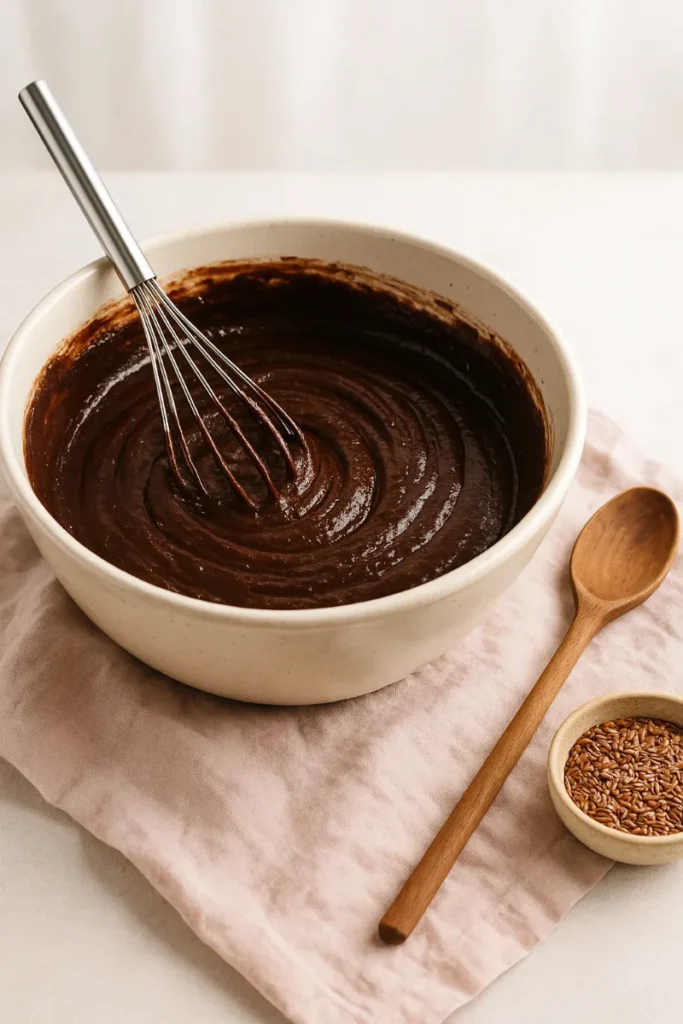
- Fold in melted vegan dark chocolate (about ¼ cup, optional). This adds richness and extra flavor.
- Divide and pour into pans. Smooth the tops with a spatula.
- Bake for 30–35 minutes. Cakes are done when a toothpick comes out mostly clean with a few moist crumbs.
- Cool in the pans for 10 minutes, then carefully turn out onto a wire rack to cool completely.
- Frost when completely cool. Don’t rush it! Warm cake + cold frosting = melted mess.
Common Mistakes to Avoid (And How to Fix Them)
Even experienced bakers hit bumps with gluten-free and vegan recipes. Here are the most common issues—and how to avoid them:
- Dry texture? You likely didn’t use enough moisture. Double-check your applesauce and milk amounts. Also, avoid overbaking—even five extra minutes can dry it out.
- Gummy or sunken center? This happens when the batter is too wet or underbaked. Be sure to measure accurately and test your cake before removing it from the oven.
- Cake won’t rise? Did you forget the vinegar? That’s your egg replacement for lift. Also, make sure your baking soda isn’t expired.
- Cracks on top? That’s usually from the oven being too hot or the batter drying out too quickly. Try lowering the temp slightly next time and use parchment to help retain moisture.
- Frosting slides off? The cake wasn’t cool. Always cool completely before decorating.
The key to success is patience and precision. Unlike traditional cakes, gluten-free vegan cakes don’t give as much room for error—but once you get the hang of it, the results are just as satisfying (and maybe even better).
Next, we’ll talk frosting, finishing touches, and how to store your cake to keep it fresh and soft.
Frosting, Storing, and Serving the Perfect Gluten-Free Vegan Chocolate Cake
The Best Vegan Chocolate Frosting (That Holds Up)
No cake is complete without frosting—and this one deserves something rich and creamy to complement its deep chocolate base. The good news? Making a smooth, decadent vegan chocolate frosting is easier than you think.
You only need 5 ingredients:
- ½ cup vegan butter (softened but not melted)
- 2 ½ cups powdered sugar (sifted for smoothness)
- ¼ cup unsweetened cocoa powder
- 2 tbsp non-dairy milk (almond, soy, or oat)
- ½ tsp vanilla extract
Steps:
- In a mixing bowl, beat the softened vegan butter until fluffy (about 1–2 minutes).
- Slowly add the powdered sugar and cocoa powder, ½ cup at a time, mixing as you go.
- Add the milk and vanilla. Beat until the frosting is light and spreadable.
- If the frosting is too thick, add a splash more milk. Too thin? Add a bit more powdered sugar.
Optional: Add ¼ cup melted vegan dark chocolate for a ganache-like richness. Just make sure it’s cooled slightly so it doesn’t melt the butter.
Once your cake is cool, frost generously between layers, then cover the top and sides. Use a spatula to create smooth waves or keep it rustic with swirls.
This frosting holds up beautifully at room temperature and even better chilled.
How to Store and Serve for Maximum Freshness
One of the most common concerns with gluten-free cakes is how to keep them moist—especially if you’re making them ahead or storing leftovers.
Here’s how to do it right:
- Room Temperature (1–2 days): Store the frosted cake in an airtight container. A cake dome or glass dish works great. If your kitchen is warm, move it to the fridge.
- Refrigerator (up to 5 days): Cover tightly and keep it chilled. Let it come to room temperature for about 20 minutes before serving so the frosting softens.
- Freezer (1–2 months): You can freeze unfrosted cake layers wrapped in plastic and foil. Thaw in the fridge overnight, then frost when ready to serve.
Serving Tips:
- Use a sharp knife wiped clean between slices for neat layers.
- Add fresh berries or a dusting of powdered sugar for a touch of elegance.
- If serving to guests with allergies, label ingredients clearly.
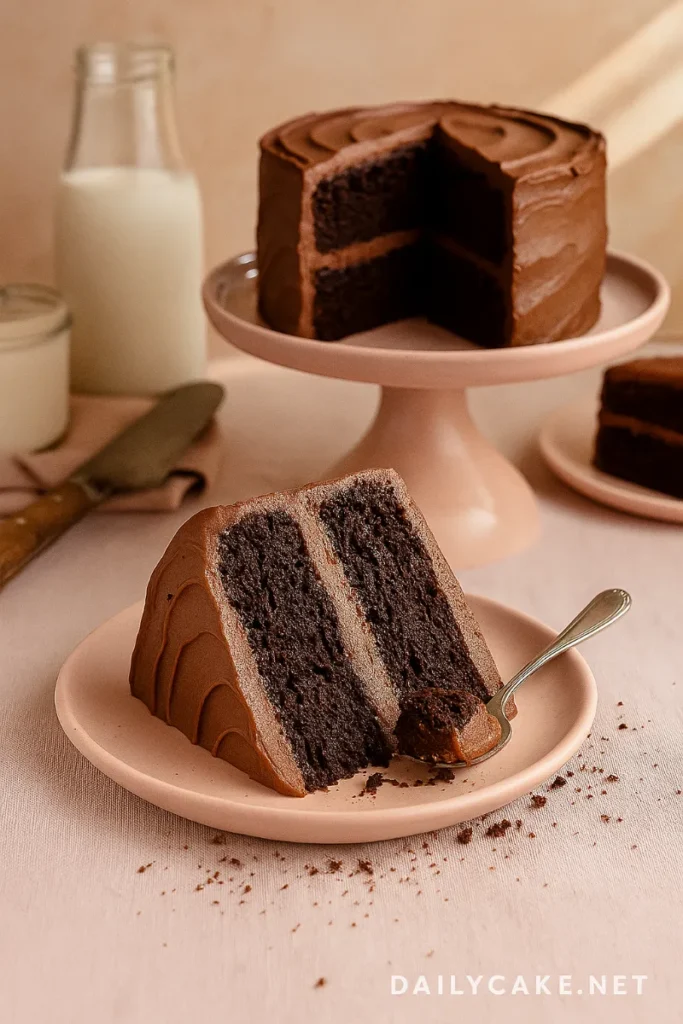
This cake makes 10–12 slices, depending on how you cut it—and it disappears fast. Don’t be surprised if even your non-vegan, gluten-loving friends ask for seconds.
Frequently Asked Questions
Can a cake be vegan and gluten-free?
Absolutely. A cake can be both vegan and gluten-free by replacing traditional ingredients like eggs, dairy, and wheat flour with alternatives. In this recipe, flax eggs, non-dairy milk, and a gluten-free flour blend work together to create a soft, rich texture that feels just like a classic chocolate cake. The key is balancing moisture and structure so it doesn’t dry out or fall apart.
What is the trick to gluten free baking?
The trick lies in understanding how gluten-free flours behave. They absorb more moisture and lack elasticity, so recipes need a little more liquid and a binding agent like xanthan gum or flaxseed. Resting the batter for a few minutes before baking and measuring ingredients carefully also improves texture. Precision and patience really pay off.
What is the best flour for gluten free cakes?
The best flour is a high-quality gluten-free all-purpose blend that contains rice flour, potato starch, and xanthan gum. These blends are designed to mimic wheat flour’s structure and texture. Avoid using single flours like almond or coconut on their own—they often result in dry, crumbly cakes unless heavily modified.
Why is it called depression cake?
“Depression cake” refers to cakes made during the Great Depression when ingredients like eggs, butter, and milk were scarce. People discovered that vinegar and baking soda could be used to make cakes rise, and oil or applesauce replaced butter. The method lives on in modern vegan baking because it works so well without animal products.
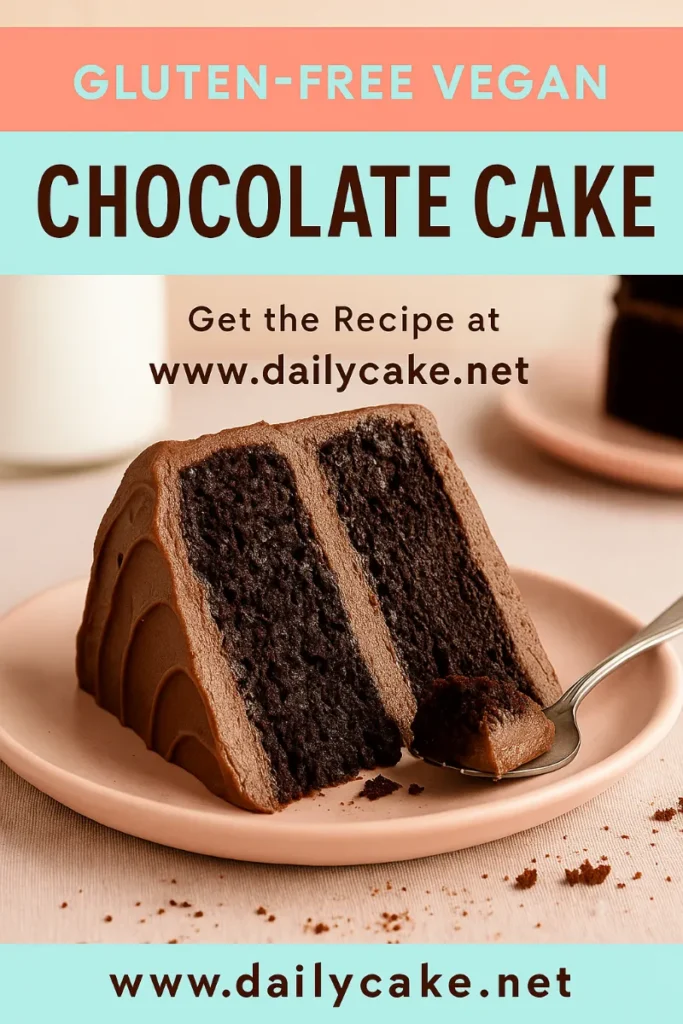
Conclusion
There’s something pretty wonderful about making a cake that almost anyone can enjoy—and knowing that it actually tastes good. This gluten-free vegan chocolate cake proves that allergy-friendly baking doesn’t have to mean sacrificing flavor or texture.
Whether you’re baking for a loved one with dietary needs, trying something new, or just want a reliable chocolate cake recipe that’s a little healthier and plant-based, this one’s for you. Every bite is rich, moist, and full of deep chocolate flavor—and best of all, it’s easy to make.
If you bake it, I’d love to see how it turns out. You can share your version or check out more recipes on Pinterest—I pin all my latest cake ideas there. You can also connect with me on Facebook to follow along with new bakes, tips, and what’s happening in my Asheville kitchen.
Try it once, and I think it’ll earn a permanent place in your recipe rotation. Happy baking—and keep the oven warm.

